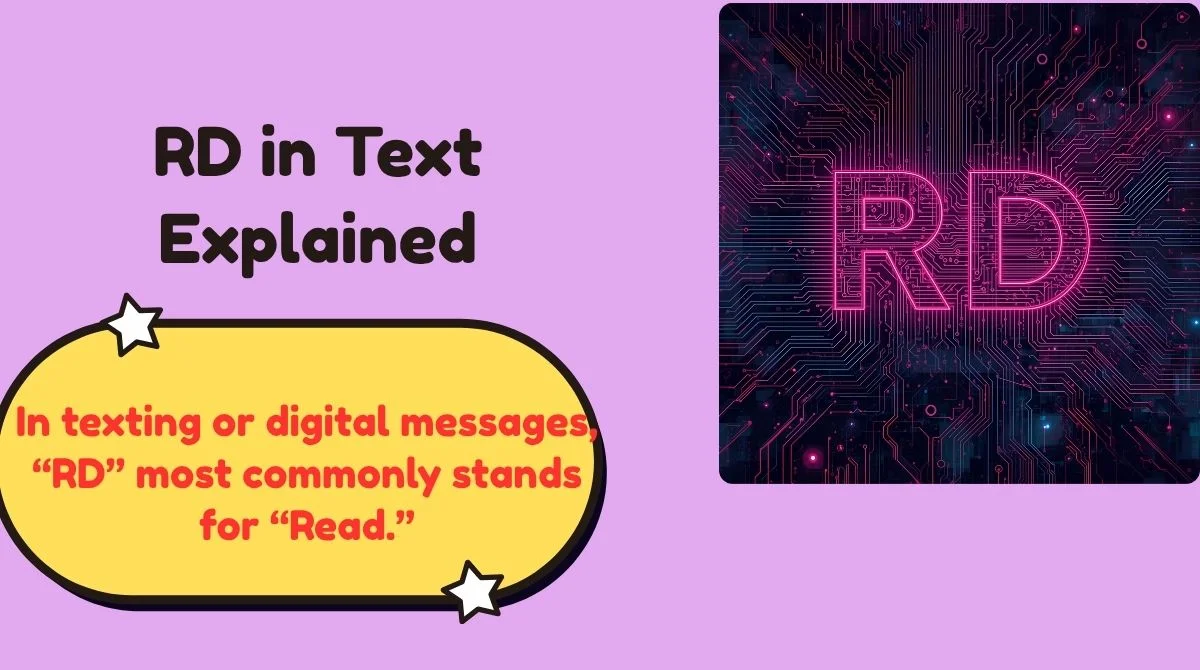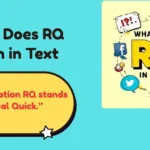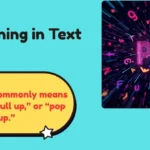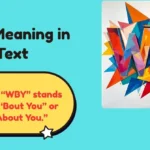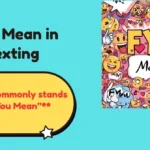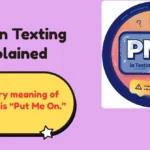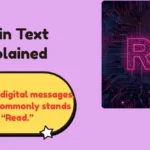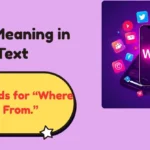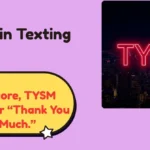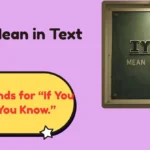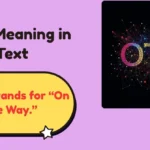Texting has its own language — fast, brief, and often confusing. You’ve probably seen someone reply with “RD” and wondered, “What does that even mean?”
This abbreviation shows up in everything from casual chats to workplace messages. But here’s the thing — its meaning isn’t always the same. Depending on the tone, platform, or relationship, “RD” can signal different intentions.
This guide breaks down what RD means in text, how to interpret it correctly, when not to use it, and what to say instead. Let’s decode it step-by-step.
What Does “RD” Mean in Text?
In texting or digital messages, “RD” most commonly stands for “Read.”
It’s a quick way to acknowledge that you’ve seen or read someone’s message.
However, it can also mean:
- Received – confirming you’ve got the message or file.
- Request Denied – used in technical or formal settings.
- Report/Request Draft – used occasionally in business communication.
📱 Common Situations Where “RD” Appears:
| Context | Meaning of RD | Example Use |
|---|---|---|
| Casual Chat | Read | “RD, will reply soon.” |
| Work Email | Received | “RD your last report.” |
| Technical Doc | Request Denied | “Your request: RD.” |
👉 In short: the abbreviation changes meaning based on context, and that’s where many people get confused.
Understanding the Tone and Context of “RD”
Casual Conversations
In personal texting, “RD” is usually shorthand for “Read.”
It’s how friends or peers tell you they’ve seen your message — especially when they’re too busy to type a full response.
Example:
You: “Did you see my last message?”
Them: “Yeah, RD.”
It’s neutral, brief, and common among Gen Z or millennial texters who love short replies. However, tone can shift depending on punctuation or follow-up.
Example:
- “RD.” → polite, neutral acknowledgment.
- “rd” (lowercase, no punctuation) → casual, maybe uninterested.
- “RD!” → enthusiastic acknowledgment.
Professional Conversations
In professional settings, “RD” can mean “Received” or “Read.”
It’s often used in emails, Slack, or Teams messages to confirm understanding.
Example:
“RD — will review and get back to you tomorrow.”
While efficient, it may come off as curt in some workplaces. If you’re messaging clients or management, it’s safer to expand it into “Received and noted” or “Got it, thanks.”
Pro Tip:
👉 In professional environments, brevity should never replace clarity.
When in doubt, write a few extra words — it prevents misunderstandings.
Apologetic or Polite Usage
Sometimes “RD” carries a softer, apologetic tone.
It’s a way of saying, “I’ve read your message, sorry for the delay.”
Example:
“Hey, RD earlier — got caught up with something.”
In this sense, it’s polite shorthand to acknowledge that you weren’t ignoring someone intentionally. Tone plays a key role here; emojis or extra words can add warmth.
Example:
“RD 😊 — I’ll reply soon!”
Why “RD” Isn’t Always the Right Choice
While “RD” is quick and practical, it can easily be misunderstood.
Text lacks facial expressions and tone of voice, so even harmless abbreviations may appear cold or dismissive.
⚠️ Key Risks of Using “RD”:
- Sounds robotic in emotional or sensitive contexts.
- May confuse older users unfamiliar with abbreviations.
- Feels abrupt in workplace communication.
- Lacks emotional tone, especially in friendly conversations.
Example of Miscommunication:
Sender: “Just wanted to tell you something important.”
Receiver: “RD.”
The receiver just wanted to acknowledge they saw it. But the sender might read that as indifference.
When and Where You’ll See “RD” Used
“RD” appears everywhere — from texting apps to corporate platforms. But the meaning subtly shifts depending on where it’s used.
📲 Common Platforms and Their RD Interpretations
| Platform | Typical Meaning | Tone | Example |
|---|---|---|---|
| WhatsApp / Messenger | Read | Casual | “RD — I’ll text back soon.” |
| Instagram DMs | Read | Friendly | “RD 😂 that meme killed me.” |
| Slack / Teams | Received | Professional | “RD your latest doc.” |
| Email Threads | Received/Read | Formal | “RD your report — thanks!” |
| Discord / Telegram | Read | Gaming/Tech | “RD, we’re set for 9 PM.” |
Each platform has its own tone culture. Slack users tend to stay brief. WhatsApp users mix humor and shorthand. Emails lean more formal.
Knowing your audience = communicating effectively.
15 Smarter Alternatives & Replies to “RD”
If “RD” feels too robotic or confusing, here are more natural, clear, and human-friendly ways to acknowledge messages.
💡 Alternatives for “RD” in Text
| Alternative | Tone | Example |
|---|---|---|
| “Got it, thanks for sending!” | Friendly | “Got it, thanks for sending the doc!” |
| “Just read it — all good here.” | Casual | “Just read it — all good!” |
| “Appreciate the update!” | Warm | “Appreciate the update — I’ll adjust accordingly.” |
| “Received and noted.” | Formal | “Received and noted, will proceed.” |
| “I’ve reviewed it — thanks!” | Professional | “I’ve reviewed it, looks great.” |
| “All clear. Thanks!” | Neutral | “All clear, moving forward.” |
| “Got your message, I’ll follow up.” | Reliable | “Got your message, I’ll update soon.” |
| “Thanks — I’ll handle it now.” | Proactive | “Thanks — on it right now.” |
| “Read and understood.” | Professional | “Read and understood, proceeding accordingly.” |
| “Message received, appreciate it.” | Formal | “Message received — appreciate the details.” |
| “Thanks for sharing — I’ll check it out.” | Friendly | “Thanks for sharing! Will check soon.” |
| “Noted, will update soon.” | Business casual | “Noted, will update you tomorrow.” |
| “Got this, give me a moment.” | Quick & polite | “Got this, I’ll check and revert.” |
| “Thanks, I’m on it.” | Efficient | “Thanks, already on it.” |
| “Fully read — good to go!” | Energetic | “Fully read — all set!” |
Pro Tip: Match your acknowledgment style to the sender’s tone.
If they’re formal, respond formally. If they’re casual, match that energy.
Choosing the Right Alternative for the Right Situation
Selecting the right response depends on three factors:
- Who you’re talking to.
- Where the conversation happens.
- What the tone of the original message was.
🔍 Quick Tone Selection Table
| Context | Best Response Style | Example |
|---|---|---|
| Workplace Email | Formal | “Received and noted.” |
| Manager Message (Slack) | Polite | “Got it, thanks for the update.” |
| Friend Chat | Casual | “Read it — all good!” |
| Client Communication | Professional | “Thank you, I’ve read and understood.” |
🧭 Quick Decision Flow
Should you use RD?
- If casual and both parties understand → ✅ Yes
- If professional or unclear → 🚫 No
- If tone could be misread → Use longer acknowledgment
Common Mistakes When Using “RD”
Even though “RD” looks harmless, it can backfire if used incorrectly.
⚠️ Frequent Pitfalls:
- Being Too Abrupt: A simple “RD” after an emotional message may sound dismissive.
- Using It in Formal Settings: Clients might see it as lazy shorthand.
- Ignoring Tone: Without emojis or context, it can feel cold.
- Using It Without Clarity: The other person may not even know what it means.
- Copying Colleagues: Just because someone else uses it doesn’t mean it fits your tone.
Example:
You: “RD.”
Manager: “What does that mean?”
Always prioritize clarity over trendiness.
The Psychology of Short Replies
Why do people use abbreviations like RD in the first place?
It’s about speed, efficiency, and emotional distance.
In fast digital communication, short replies make people feel in control — like they’re managing time effectively. But there’s a hidden cost.
According to communication psychology, brevity can be misread as detachment. When you type “RD,” you might think you’re saving time, but others might think you’re brushing them off.
Case Study:
A small team at a digital marketing agency noticed clients were misinterpreting “RD” in Slack updates as unresponsive behavior. After switching to longer acknowledgments like “Got it, will handle this”, client satisfaction scores rose by 14% in two weeks.
Lesson: The extra three seconds to type clearly are worth it.
RD Across Cultures and Generations
Different generations and cultures read “RD” differently.
- Gen Z often use “RD” as part of fast-paced texting. It’s common and casual.
- Millennials might mix it with emojis or abbreviations like “BRB” or “ICYMI.”
- Older users (Gen X, Boomers) might not recognize “RD” at all — leading to confusion or misinterpretation.
Culturally, in some English-speaking regions (like the US or UK), brevity is normal. In others (like Japan or India), longer and more polite responses are the norm.
🌍 Cross-Cultural Tip:
If you’re messaging internationally, avoid overly short replies like “RD.” Use “Received and noted” or “Got it, thank you” instead.
FAQs About “RD” in Text
What does “RD” mean in text?
It usually means “Read” or “Received.” It’s shorthand to confirm that you’ve seen or acknowledged someone’s message.
Is it rude to reply with “RD”?
It can be, depending on tone. If you’re messaging friends, it’s fine. In formal or emotional conversations, it might sound cold or dismissive.
Can I use “RD” in emails?
Yes, but only in internal or informal messages. Avoid using it with clients or external partners — write “Received and noted” instead.
Does “RD” mean the same on all platforms?
No. On WhatsApp it means “read,” but in professional chats, it often means “received.” Context defines its meaning.
What’s the best way to respond if someone sends “RD”?
You can say “Thanks for reading!” or “Glad you saw it.” Keep it light and polite.
Final Thoughts: Speak With Clarity, Read With Empathy
At its core, “RD” in text is just a quick acknowledgment. But clarity and tone make all the difference.
In 2025, communication happens faster than ever — but speed should never replace empathy. The best communicators know how to balance brevity with warmth.
So next time someone sends “RD,” pause for a second.
Did they mean “Read,” “Received,” or “Request Denied”?
And when you send it — ask yourself, Could this be misunderstood?
Clear words build trust. Short ones don’t always save time — sometimes, they cost connection.
